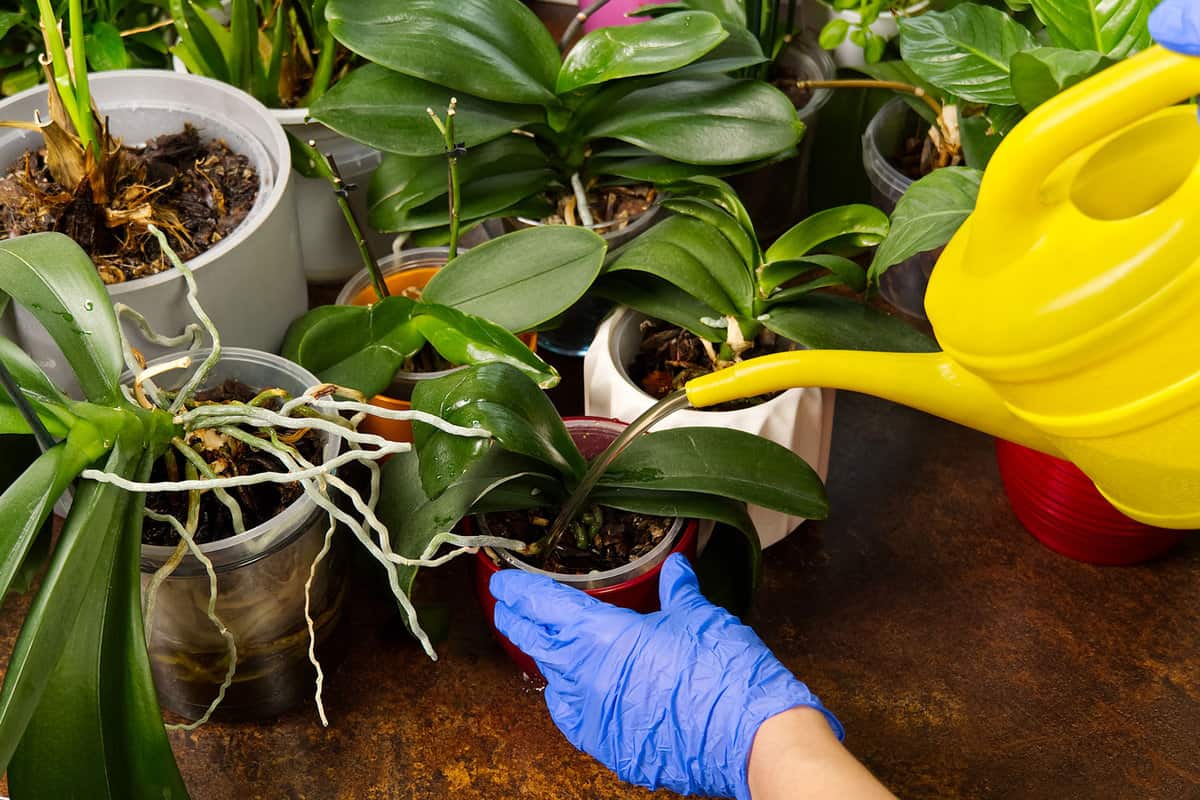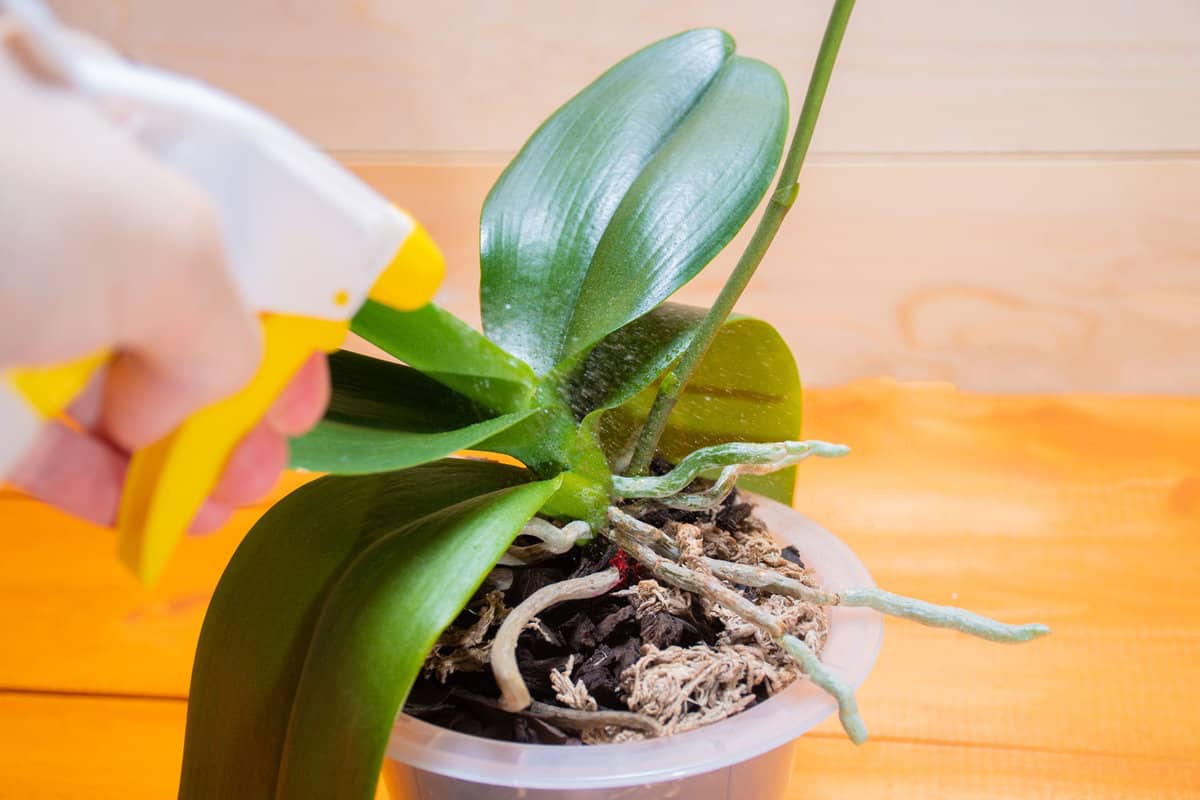Orchids are a symbol of beauty and elegance with their vibrant colors and delicate petals.
A critical aspect of orchid care is understanding their watering requirements, which significantly differ from other houseplants.

This makes orchid care often feel complex for new gardeners, and others even feel intimidated to care for orchids.
We'll break it down for you. This article will help you understand the process of orchid watering, plus hacks to keep your orchids thriving.
Orchid Watering Needs
The first aspect to consider is that orchids are not like regular houseplants, and therefore, their watering requirements differ.
They are epiphytic, meaning they grow on trees and other surfaces in their natural habitat, rather than in soil.

This indicates they need excellent drainage and a unique growing medium, such as orchid bark or moss.
Orchids are native to tropical regions, where they often grow in more humid and airy environments compared to traditional soil-based plants.
Different Watering Requirements Per Orchid Type
The type of orchid you have will largely dictate its watering needs.
For example, the popular moth orchid (Phalaenopsis) needs more water when it's actively growing and during bloom.
On the other hand, some other orchids, like Dendrobiums, might require a seasonal water reduction to stimulate blossoming.
Ideal Watering Environment
Here are the different aspects of watering orchids indoors and outdoors.
Indoor Orchids
When growing orchids indoors, it's important to find a balance between providing enough moisture and preventing excessive humidity.
To achieve this balance, you should water your orchids every 7 to 10 days, allowing the potting medium to dry out slightly between waterings.
When watering, make sure the water runs through the pot completely, ensuring that the roots have been thoroughly soaked.
It is also essential to avoid letting your orchids sit in a tray of water, as this can lead to root rot.
To maintain a consistent humidity level, you may consider using a humidifier near your orchids or placing their pots on a tray of moist pebbles.
Misting the leaves is another option, but be cautious not to overdo it, as excess moisture on the leaves can lead to fungal issues.
You can check here the possible diseases and fungal issues orchids can get: Orchid Pest and Disease Control.
Outdoor Orchids
Orchids grown outdoors often have different watering requirements than their indoor counterparts.
Factors such as temperature, humidity, and rainfall will play a significant role in determining how often you should water your outdoor orchids.
In general, you should ensure that your outdoor orchids are kept consistently moist, but not wet.
During hot, dry periods, you may need to water your outdoor orchids daily, while in cooler or more humid conditions, you may only need to water them once or twice a week.
Keep your eye on the potting medium and the orchid's leaves for visual cues to help you determine when it's time to water.
If the medium is dry to the touch or the leaves appear slightly wrinkled, it's likely time to water.
Watering Methods
Orchids have unique watering requirements compared to other houseplants, so it's essential to understand the various methods available to keep your orchids healthy.
Misting
Misting is a gentle way to water your orchids, as it closely mimics their natural environment where they absorb moisture from the air.
To mist your orchids, simply use a spray bottle filled with water and lightly mist the orchid leaves and aerial roots.
Be careful not to overdo it – just a light misting is enough to provide the needed hydration.
- Pros: Mimics natural environment, gentle on the plant
- Cons: May not provide enough water for some orchid types
Soaking
Soaking is a more thorough method for watering your orchids and is particularly useful for plants that prefer consistent moisture.
To soak an orchid, place it in a sink or container and fill with water until it covers the pot's bark mix.
Allow the orchid to soak for about 15 minutes, then drain the excess water by allowing it to run out of the drainage holes.
- Pros: Provides thorough and consistent water, great for thirsty orchids
- Cons: May be too much water for some orchid types, requires a bit more time
Underwatering
Underwatering, as the name suggests, involves providing less water to your orchids than the other two methods.
This technique is best for orchids that naturally receive less water in their habitat, like those found in arid environments.
To underwater your orchid, water the plant sparingly and allow the potting medium to partially dry out between each watering session.
Keep an eye on your orchid's leaves and roots, as they will give you clues if the plant needs more moisture.
- Pros: Helps prevent overwatering, suitable for arid-climate orchids
- Cons: May lead to dehydration if not monitored carefully
Remember, it's essential to tailor your watering methods to the specific needs of your orchid species and adjust as needed.
Watering Frequency
Orchids prefer to dry out between waterings, which typically translates to a watering routine of once a week.
However, this can vary based on the type of orchid, the temperature, and the humidity level in your home.
Water Quality
Orchids are sensitive to the minerals and chemicals in tap water. It’s advisable to use rainwater, distilled, or filtered water to prevent leaf tip burn and other potential issues.
The Right Time to Water Orchids
Seasonal Differences
During different seasons, your orchids will require different watering frequencies.
In warmer months, such as spring and summer, you might need to water your orchids more often, as the heat and increased light levels can cause the potting medium to dry out faster.
In contrast, during colder months, like fall and winter, orchids tend to grow more slowly and require less frequent watering.
And in case you're wondering about their survival during the colder season, read here: Can Orchids Survive Winter Outside?
Time of Day
The best time to water your orchids is in the early morning.
This gives your plants enough time to absorb the water and allows them to dry out before the cooler evening temperatures set in, which helps prevent unwanted fungal growth.
Avoid watering your orchids during the night or in the late afternoon, as this can lead to waterlogging and potential diseases.
Remember, the key to healthy orchids is a proper balance between keeping them moist but not soggy.
3 Watering Hacks for Orchids
1. Double Potting
Place your orchid in a smaller pot, and then place that pot within a larger one.
This way, when you water your orchid, any excess will be caught by the outer pot, preventing waterlogging.
2. Humidity Trays
Increase humidity around your orchids by placing a shallow tray filled with pebbles and water underneath the pot.
As the water evaporates, it'll create a more humid environment, akin to their natural habitat.
3. Weekly Drench
Instead of a set schedule, adopt a weekly routine where you check if your plant needs watering.
If it does, use the drenching routine where you water the orchid thoroughly until water runs through the drainage holes, mimicking a tropical rainstorm.
Confidence in Caring for Orchids
By understanding the unique watering needs of orchids and employing these simple hacks, you can cultivate a lush, blooming garden of these exquisite beauties.
As you cultivate your greens, remember to be patient and adapt to their needs, and soon you'll become a confident orchid caretaker!
